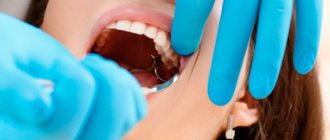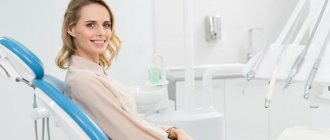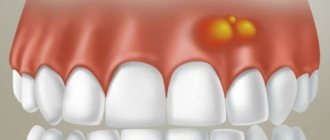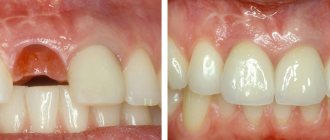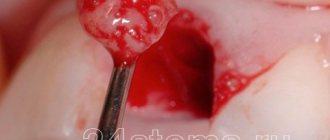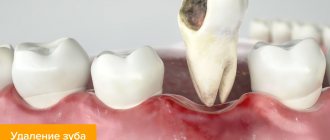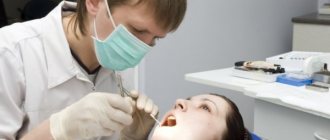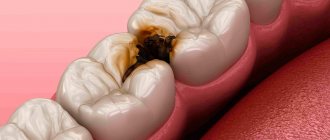- Treatment of the hole after tooth extraction
- Complementary therapy
- Help from qualified dentists at the International Center for Health Care
Alveolitis is an infectious inflammation of the tooth socket and surrounding gums. This is a failure of wound healing, a common complication that develops after tooth extraction. The lesion is often accompanied by bone trauma and damage to nearby tissues.
The disease can also affect the lower respiratory tract, in which case it is called idiopathic fibrosing alveolitis. It affects the connective tissue of the lungs.
Other names for the disease affecting the oral cavity are dry socket syndrome, alveolar osteitis. This is due to the peculiarities of wound healing failure. After extraction, a blood clot forms in the cavity. It must protect it from mechanical damage and infections. But this thrombus is often destroyed until the alveolar bone is exposed, breaking the entire system of tissue regeneration and causing the development of an inflammatory process. Rotting food debris and saliva infects the open wound and contributes to the active spread of infection.
The disease often occurs after the removal of a wisdom tooth. The cause of inflammation can also be a complicated operation. Extraction of a tooth from the dental alveolus is considered difficult if:
- fragile dental tissue crumbles when touched by instruments;
- the roots are curved or interlocked with the roots of other teeth;
- the upper part of the tooth is destroyed, only the root remains.
In such situations, an incision in the gum is necessary, the tooth is extracted in parts or cut out using a drill. Additional injuries always create a favorable environment for the launch and development of the inflammatory process.
Reasons for the development of the disease
Signs of alveolitis can be detected after poor-quality, incomplete tooth extraction. Most often this happens when the doctor leaves some tissue in the socket. But the pathology can also be caused by the patient’s neglect of the rules of personal hygiene.
The etiology of the lesion includes other causes. The following circumstances can trigger the development of infection:
- chronic inflammation of the gum tissue;
- accumulations of soft or hardened plaque;
- caries on adjacent teeth;
- weakened, decreased immunity, autoimmune disorders;
- insufficient antiseptic treatment;
- fragments of pathological tissue remaining deep in the cavity;
- eating rough, hot, spicy food after tooth extraction.
Nutrition after implantation
The diet should be rich in vitamins and minerals, since the introduction of an artificial tooth is an operation, that is, stress for the body. Also, during the manipulation process, the body lost a certain amount of blood, and this deficiency must be replenished.
The diet should include vegetables, fruits, lean meats, fish, cereals, and dairy products.
Products should be soft; soups can be pureed. Avoid eating too hard foods (carrots, apples, nuts). It is necessary to exclude fast food, soda, alcoholic and low-alcohol drinks from the diet.
Symptoms of alveolitis after removal
The first time after tooth extraction, alveolitis may hardly manifest itself at all. But the disease quickly progresses, spreads to nearby tissues and penetrates the cavity. 2-3 days after tooth extraction surgery, the first clinical manifestations appear:
- discomfort in the socket area;
- mild pain while eating;
- discomfort when opening the mouth;
- fatigue, exhaustion, headaches, feeling of weakness;
- increased body temperature;
- enlargement of the submandibular lymph nodes;
- redness and swelling of the gums;
- severe bad breath.
With alveolitis of the hole after tooth extraction, you can visually observe a significant decrease or complete absence of a blood clot and suppuration. As soon as the lesion begins to develop and progress, the patient experiences pain in the area of the extracted tooth. At a certain point, they acquire a shooting character and can spread to the temples or even the jaw. The acute form of alveolitis is accompanied by an increase in temperature to 38-39°C. With advanced disease, damaged tissues become bluish as necrosis begins.
Solcoseryl instructions for use
Solcoseryl, instructions for use
Dosage form: gel and ointment
Indications for use:
- Solcoseryl gel/ointment is used in the following cases:
- minor damage (abrasions, scratches, cuts)
- 1st and 2nd degree burns (sunburn, thermal burns)
- frostbite
- difficult-to-heal wounds (including trophic ulcers and bedsores).
For the treatment of trophic lesions of tissues of various origins, Solcoseryl is used only after removal of necrotic tissue from the wound.
Solcoseryl gel is used in the initial stage of treatment and is applied to fresh wounds, wounds with wet discharge or ulcers with weeping phenomena.
Solcoseryl ointment is used primarily for the treatment of dry (non-wetting) wounds.
Contraindications
Hypersensitivity to one of the components of the drug.
Use with caution if you are predisposed to allergic reactions.
Types of alveolitis after tooth extraction
Alveolitis comes in several types:
- Serous
. It is characterized by constant, never-ending aching pain. When trying to eat food, they intensify. Lymph nodes are not enlarged, body temperature does not increase. This form of the disease lasts a week, after which the transition to the next stage is inevitable. - Purulent
. The developing infection affects the patient's condition. Due to intoxication, weakness, lethargy appear, temperature rises, and pain increases. The affected area swells, and the face may also swell. Upon examination, pus and plaque are visible on the hole. The mouth opens with difficulty, which causes an unpleasant odor. - Hypertrophic
. A chronic purulent process, which is characterized by subsidence of symptoms. The lymph nodes are normalized, most of the clinical manifestations disappear, and the temperature drops. The examination can reveal the proliferation of granulations. The gum tissue takes on a bluish tint, and pus is released from the wound.
Diagnosis of inflammation
To make an accurate diagnosis, you need to visit a dentist. He carefully examines the oral cavity. The patient's complaints and visual examination are usually sufficient to diagnose the pathology. In some situations, additional research may be needed. These include x-rays, computed tomography, and electromyography.
In the mouth, the doctor detects a plaque with a characteristic yellowish or greenish tint. There may be a blood clot in the hole, but it is decomposing. In complicated cases, the bone tissue is exposed. In addition to suppuration, the patient has a foul odor from the mouth.
Differential diagnosis is not a difficult task, since the symptoms of the disorder are very specific. Swelling with alveolar osteitis is small, it looks like a slight swelling. This distinguishes this disorder from many oral pathologies.
Treatment of the hole after tooth extraction
At the first clinical manifestations of alveolar osteitis or its suspicion, it is advisable to consult a dentist. Self-medication is not allowed here. Any incompetent actions will only worsen alveolitis, complications can be very serious.
Many, not wanting to go to the clinic, resort to taking antibiotics and rinsing. But such manipulations are useless without the main procedure, which can only be performed by a doctor - to clean the hole from necrotic decay products and inject medicine into it.
For dental alveolitis, treatment consists of a number of procedures:
- Removal of pus, food debris, necrotic plaque
. The walls of the socket are cleaned, and the patient is first given anesthesia. - Rinsing the well with antiseptics
. An antiseptic is placed inside it. This could be the antibiotic Neocones cones or alvostasis. - Taking antibiotics, antiseptic baths, painkillers
. All these remedies are prescribed by the dentist based on the characteristics of the patient’s situation. - Taking Solcoseryl dental adhesive paste
. It is prescribed 2-3 days after the acute symptoms subside. The paste relieves pain and promotes wound healing.
It is important to see your doctor until the hole heals completely. Following all his instructions is the key to a quick recovery.
How to care for your oral cavity after implantation?
Dental care after implantation
- The first 72 hours after each meal - rinse with an antiseptic solution. Chlorhexidine, miramistin and analogues are suitable without restrictions, if there is no individual intolerance.
- For cleaning, use only a soft brush and pastes with a complex of herbs, without bleaching components. It is recommended to clean the base of the implant with a special brush with one row of bristles - they are sold in most pharmacies.
- If food fragments remain on the pin, it is better to buy dental floss for dentures, and under no circumstances use toothpicks.
- A decoction of chamomile or calendula not only reduces pain, but also provides an additional disinfecting effect. You can rinse up to 7-8 times a day.
- The bleeding hole where the rod was installed should be washed separately for the first few days; it is allowed to use soft cotton swabs or thin swabs moistened with an alcohol-free antiseptic.
- If 3 or more implants are placed on one jaw, it is recommended not to use a brush at all for the first week, but to limit yourself to gentle rinsing.
- When rinsing your mouth, you should not “bubble” the solution too much. Excessive efforts can slow down the healing of seams.
Complementary therapy
To speed up the recovery of the inflamed area, especially if necrosis has already developed, additional methods are used. Your doctor may recommend:
- treat the hole using UV radiation / infrared laser;
- use the balneotherapy procedure;
- perform smoothing in case of exposed bone tissue;
- undergo a course of fluctuarization/microwave therapy;
- start taking vitamin complexes.
It is allowed to make baths with herbal decoctions. St. John's wort, chamomile, oak bark, and calendula are suitable for these purposes. Vitamins should be chosen that are aimed specifically at strengthening dental tissues.
These procedures can be continued until pain stops completely. After a week, the walls of the hole heal and begin to become covered with young mucous tissue. However, symptoms of inflammation may still be present. After about 2 weeks, the swelling subsides and the mucous membrane acquires a normal pink color.
News
oral cavity after implantation
Oral care after dental implantation Dental implantation is a complex multi-stage process that requires a responsible attitude not only from the doctor performing the operation, but also from the patient himself. In order to reduce the risk of complications and implant rejection to a minimum, and to maximize its service life, it is necessary to strictly follow the doctor’s instructions, including those regarding the specifics of hygienic oral care at various times after implantation.
These recommendations are especially important at the postoperative stage, because the oral mucosa is still vulnerable to infection. As a rule, surgical intervention is accompanied by incisions and suturing. Therefore, all postoperative therapy is aimed at two points:
— the first point: do not allow infection to attach to the surgical field (to the sutures);
- second point: speed up the healing process of medical incisions.
Based on this, a postoperative treatment plan was developed. Consider the "destination sheet":
1. Flemoklav (500 mg) solutab (or amoxiclav or augmentin) is an antibiotic, it should be taken one tablet 3 times a day for 5-7 days.
In our clinic, the operations are quite complex, voluminous (installation of an implant with simultaneous tooth extraction, with a bone substitute, with a sinus lift, with plastic surgery with an autologous bone block) and very often long-term (due to the fact that we try to carry out all operations in one surgical procedure necessary for the patient). That is why the doctor prescribes an antibiotic.
Antibiotics are not prescribed in completely simple cases of installing one or two implants (when there is enough bone, the incisions were minimal).
2. Erius is an antihistamine that helps reduce or eliminate the inflammatory process after implantation, one tablet once a day at night for 3 days. The drug is modern; according to the old regimen, Suprastin and Tavegil were prescribed. Erius, unlike suprastin and tavegil, does not cause drowsiness, the individual reaction is weakly expressed.
3. Voltaren (or Nurofen, or ibuprofen) 1 tablet 1-2 times a day for 3 days. A non-steroidal anti-inflammatory drug is aimed at reducing swelling and reducing the inflammatory component after surgery.
4. Linex is a probiotic, prescribed simultaneously with taking antibiotics, because Taking an antibiotic orally is accompanied by changes in the gastrointestinal tract (dysbacteriosis, thrush, candidiasis). To prevent these undesirable consequences, prescribe Linex 2 capsules 3 times a day for 2 weeks.
5. Ascorbic acid – required up to 0.5 g per day, i.e. 200 – 500 mg per day for a month. It is known that ascorbic acid is an essential component of metabolism. Our task is to ensure a full metabolism during the operation stage, to enable the body to quickly recover after the operation.
6. Multivitamins – 1 tablet 3 times a day. The same need arises for prescribing multivitamins (any).
7. Calcium D3 nomed - after antibiotics for a month.
Any surgical operation is accompanied by bone trauma. Calcium is the main component of bone tissue and an essential mineral.
At your discretion, you can use any calcium supplement, as well as very good absorption of calcium from yogurt, cottage cheese, kefir, sour cream, i.e. any fermented milk products. Therefore, we strongly recommend a fermented milk diet for a month.
8. Tantum Verde solution - baths. (not to be confused with Tantum Verde - spray) - from the first day 3-4 times a day.
This is a very important hygiene component. The wound and stitches must always be clean, for this it is necessary to maintain hygiene. How? Place 1 cap of Tantum Verde solution in your mouth and hold for 2-3 minutes. They spat. Why Tantum Verde? Only it does not inhibit epithelization, which is so necessary in the area of the operation. Studies have shown that the antiseptic components included in Tantum Verde perfectly fight microbes and do not interfere with the healing process.
Use the drug from the first day until the sutures are removed, and in some cases for another week after the sutures are removed.
9. Solcoseryl dental adhesive paste is a completely harmless drug obtained from the blood of calves. After rinsing, apply Tantum Verde generously to the area where the operation was performed (suture area). It should be in the mouth constantly; in some cases, the doctor recommends keeping the sutures in place 24 hours a day to speed up recovery and epithelization.
10. Cold: apply ice or any other frozen product to the intervention site on the day of surgery until the evening and until half the next day.
According to the schedule - hold for 20 minutes, break for 20 minutes, so as not to cause frostbite on the superficial areas of the skin.
11. Naphthyzin – nasal drops, two drops 4 times a day. It is prescribed only after operations on the upper jaw, when the installation of a dental implant is accompanied by simultaneous raising of the bottom of the maxillary sinus (sinus lift operation).
Or other vasoconstrictor drops, but drip for no more than 5 days. If sinus lifting is performed on both sides, then instill in both nostrils. For what? To reduce internal swelling of the Schneiderian membrane at the site of the sinus lift.
12. Don’t blow your nose, don’t sneeze, don’t cough!!! Carefully remove discharge from the nose with a handkerchief!!! Having performed a sinus lift, the doctor will prohibit active morning toileting for 2-3 weeks, because... Each such tension in the ear-nose-throat system leads to an increase in pressure in the maxillary sinus, which can have an adverse effect, including rupture of the membrane and eruption of the bone substitute.
13. Traumeel S – tablets – according to the scheme. This is a homeopathic drug with anti-inflammatory wound healing properties. Should not be taken with tea, coffee, alcohol, nicotine, carbonated drinks, or citrus fruits. They nullify the effect of the drug. Homeopathy cannot be mixed with other medicines. Or it must be taken with a long time interval.
14. Ketanov – one tablet under the tongue for 12 hours. As a rule, 95% of our patients do not experience pain; in the remaining 5% of cases, Ketanov copes well with pain.
How to behave in the postoperative period for two weeks.
1. Avoid physical activity and stressful situations. You cannot engage in sports, fitness, or cancel sports training and exercises. Do not climb to high floors on foot. Do not travel long distances by bicycle. As soon as there is a rush of blood to the head, we get uncontrollable swelling that will increase.
2. Do not visit the bathhouse or swimming pool.
3. Refrain from flying.
4. Food: semi-liquid food, or regular food, passed through a blender or very finely chopped.
5. Eliminate spicy and hot foods from food.
Possible side effects.
- swelling of the soft tissues of the face (the degree of swelling varies from person to person)
- hematomas, bruises. They appear on day 2-3, go down and disappear within 5 days;
- ichor (saliva mixed with blood);
- aching pain for 1-2 days.
You need to be prepared for these things; anything like this can be dealt with.
Recommendations for oral care.
— After each meal, rinse with Tantum Verde, then generously cover the seams with solcoseryl dental adhesive paste;
- cleaning the teeth in the wound area using cotton swabs soaked in a 3% solution of hydrogen peroxide; brush the rest of your teeth well.
Sutures are usually removed on the 10th day, sometimes at the doctor’s discretion - on the 20th day. The clinic uses synthetic threads that hold the operating flap well in place and do not allow germs to settle; do not get wet, do not swell. The fishing line has one drawback - the sharp edges of the remaining thread interfere with the tongue and are a little prickly. There is a way out of this: generous application of solcoseryl at the seam site. Then follow the doctor's recommendations.
Be healthy!
Help from qualified dentists at the International Center for Health Care
The International Center for Health Protection provides treatment for alveolitis at the prices indicated in the price list. All necessary services are already included in the price. If necessary, we will explain all components of the final amount. Here you can undergo a comprehensive examination, instrumental and laboratory diagnostics, and receive advice from experienced dentists. The quality level of services provided is confirmed by the international TUV certificate.
Treatment prescribed for alveolitis of the tooth socket includes freeing the socket from foreign bodies and pus, antiseptic treatment of tissues, and follow-up to promote complete healing and recovery. Our multidisciplinary medical center has a convenient location in Moscow - it is a 5-minute walk from the Dostoevskaya metro station, a 15-minute walk from the Novoslobodskaya metro station. You can make an appointment by phone.
Professional cleaning is especially important
To prevent negative diseases of teeth and gums, professional teeth cleaning is recommended - 2 times a year. Even though metal-ceramic crowns do not lose their color, they also need to be cleaned. Dental cleaning will prevent possible complications and the development of the inflammatory process.
Zuub.rf dentists will tell you in more detail what to do after dental implantation in your specific case. Experienced specialists will also advise on existing implantation programs and the recovery period so that the installation of new teeth is high-quality, painless and with an impeccable result!
If you have the symptoms described in this article, be sure to make an appointment at our clinic.
Don't self-medicate! Even the smallest problem, if not treated correctly, can significantly complicate your life.
By contacting us, you can be sure that:
- Get high-quality and free consultation .
- You will receive the best prices for treatment and the opportunity to receive a special promotional price.
- Only modern equipment and materials will be used.
- You will be treated by professional doctors with many years of experience.
- We offer treatment on credit or in installments. There is also the possibility of obtaining a tax deduction.
- We work seven days a week and without a lunch break, from 9 a.m. to 10 p.m.
+7 (495) 132-02-96
Make an appointment
